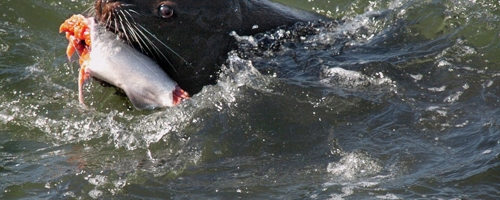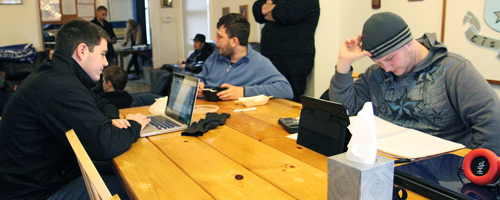How has the media covered the contentious issue of salmon-eating sea lions in the
Columbia River in the last six years? Students and nonstudents gathered at the Native American Student and Community Center on Tuesday to hear Dr. Cynthia-Lou Coleman discuss a two-part report that examined the framing of news coverage and public opinion surrounding the sea lion and salmon conflict on the Columbia River.
Research finds Native American input not included
[portfolio_slideshow id=45618]
How has the media covered the contentious issue of salmon-eating sea lions in the Columbia River in the last six years?
Students and nonstudents gathered at the Native American Student and Community Center on Tuesday to hear Dr. Cynthia-Lou Coleman discuss a two-part report that examined the framing of news coverage and public opinion surrounding the sea lion and salmon conflict on the Columbia River.
Coleman is the chair of PSU’s Department of Communication.
The Columbia River is crucial to local Native Americans because of the salmon that their culture relies upon for spiritual and nutritional sustenance. The construction of the Bonneville Dam in 1938 drastically decreased the number of salmon in the river, and hatcheries—both tribal and those funded at the state and federal level—have since produced fish to keep the runs alive.
In the last decade, an increasing number of sea lions have been entering the Columbia River, congregating in the area surrounding the dam to dine on federally protected salmon.
“Sea lions have been encroaching on the dam and eating the salmon,” Coleman said. “Something has to be done with the sea lions.”
Various methods to remove the sea lions have been discussed in a conversation that has been spread throughout the globe. Some call for relocation of the sea lions, while others want them killed. Any efforts to remove them have been highly controversial with animal rights advocates.
The study—which was funded by grants from the Spirit Mountain Community Fund of the Confederated Tribes of Grand Ronde and through research and strategic partnerships at Portland State—examined the similarities and differences between news coverage and public opinion surrounding this conflict, and the issues dominating news stories.
Media and residents were able to slightly agree about who or what is to blame for the decline of the salmon population, she said. Both parties placed the majority of the blame on the sea lions, Coleman said.
While both parties are able to agree on some aspects, other views on the issue don’t always align.
“Media sometimes impacts mental frames and public opinions, but they don’t always resonate with residents,” Coleman said.
Residents’ views were more expansive, also focusing on factors like politicians, the dam, and commercial and native fishermen.
News media tended to favor legislators and other governmental sources for their stories, and relied very little on the input of Native Americans or organizations like the Humane Society, Coleman said.
Though the river and wildlife are maintained by federal and state organizations, Native Americans were referenced very little despite their significant stake in the Columbia River and its resources, Coleman found. This differs from public opinion, which considers Native American tribes and commercial fishermen as key stakeholders in the issue, she said.
“For something so crucial to their society, they were only quoted 9 percent of the time,” Coleman said.
Attitudes toward environmental issues were also studied in relation to sea lion management. Results tended to either align with balancing nature or controlling it, Coleman found.
The study discovered that those who favored balancing nature were more in favor of sea lion relocation and were opposed to any lethal removal, while, in contrast, the residents who leaned toward controlling nature tended to support lethal removal of sea lions.
Results found that news coverage mirrored public opinion in some ways, while in other instances it did not. Attitudes about the environment tend to be a likely indication of blame about the sea lion and salmon conflict, and much more accurate.
Coleman’s closing remarks concluded the presentation and opened the floor for other speakers, such as Charles Hudson, the intergovernmental affairs director for the Columbia River Inter-Tribal Fish Commission.
Hudson discussed the impact this conflict has on Native Americans and shared information about their efforts, which he feels have been underrepresented in the media.
The logistic difficulty of relocating or removing the sea lions was also a hot topic of discussion. The current debate is whether to leave them, relocate them or kill them, Hudson said. Relocating them is one of the favored options, but “not many can be sent to a place like SeaWorld,” he said.






